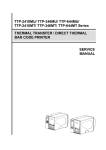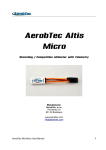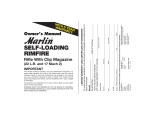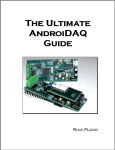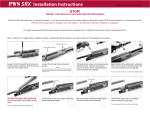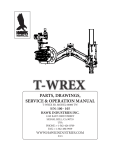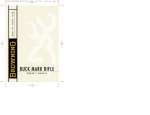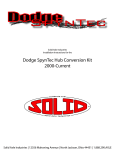Download T3 Summit User Manual - Shade Mountain Armory
Transcript
PWS Summit Series User Manual ver 110111 TM 9-PWS-SS State-By-State Warnings State-By-State Warnings (continued) State-By-State Warnings Certain states require by law that their own specified warning notices be conspicuously included by the manufacturer, distributor, or retail dealer with firearms sold in that state. Primary Weapons Systems sells its products in compliance with applicable laws and regulations. Because our products may be sold in these states, we include the following: California Massachusetts This rifle is not equipped with a device that fully blocks use by unauthorized users. More than 200,000 firearms like this one are stolen from their owners every year in the United States. In addition, there are more than a thousand suicides each year by younger children and teenagers who get access to firearms. Hundreds more die from accidental discharge. It is likely that many more children sustain serious wounds, or inflict such wounds accidentally on others. In order to limit the chance of such misuse, it is imperative that you keep this weapon locked in a secure place and take other steps necessary to limit the possibility of theft or accident. Failure to take reasonable preventative steps may result in innocent lives being lost, and in some circumstances may result in your liability for those deaths. It is unlawful to store or keep a firearm, rifle, shotgun, or machine gun in any place unless that weapon is equipped with a tamper-resistant safety device or is stored or kept in a securely locked container. Children are attracted to and can operate firearms that can cause severe injuries or death. Prevent child access by always keeping guns locked away and unloaded when not in use. If you keep a loaded firearm where a child obtains and improperly uses it, you may be fined or sent to prison. New Jersey Connecticut New York City Unlawful storage of a loaded firearm may result in imprisonment or fine. Florida It is unlawful, and punishable by imprisonment and fine, for any adult to store or leave a firearm in any place within the reach or easy access of a minor under 18 years of age or to knowingly sell or otherwise transfer ownership or possession of a firearm to a minor or a person of unsound mind. Maine Endangering the welfare of a child is a crime. If you leave a firearm and ammunition within easy access of a child, you may be subject to fine, imprisonment or both. Keep firearms and ammunition separate. Keep firearms and ammunition locked up. Use trigger locks. Maryland Children can operate firearms which may cause death or serious injury. It is a crime to store or leave a loaded firearm in any location where an individual knew or should have known that an unsupervised minor would gain access to the firearm. Store your firearm responsibly! It is a criminal offense to leave a loaded firearm within easy access of a minor. The use of a locking device or safety lock is only one aspect of responsible firearms storage. For increased safety, firearms should be stored unloaded and locked in a location that is both separate from their ammunition and inaccessible to children and other unauthorized persons. North Carolina “It is unlawful to store or leave a firearm that can be discharged in a manner that a reasonable person should know is accessible to a minor. Texas It is unlawful to store, transport, or abandon an unsecured firearm in a place where children are likely to be and can obtain access to the firearm. Wisconsin If you leave a loaded firearm within the reach or easy access of a child you may be fined or imprisoned or both if the child improperly discharges, possesses, or exhibits the firearm. Please check with your licensed retailer or state police for additional warnings which may be required by local law or regulation. Such regulations change constantly, and local authorities are in the best position to advise you on such legal matters. 2 3 Locking Device Installation Instructions Use of locking devices 1. 2. 3. 4. 5. 6. Always keep your firearm pointed in a safe direction, including when you are installing or removing a locking device. Always verify that your firearm is safe (completely unloaded) before installing your locking device. Do not install a locking device in the trigger guard; always keep your fingers and locking device away from the trigger during device installation and removal. Store firearms, ammunition and keys separately and securely, away from children and careless adults; do not store your firearm with the keys in the locking device. Do not attempt to cycle the action of your rifle with the locking device in place; this could cause damage to your firearm While locking devices are an important aid to security measures, they are not a substitute for safe firearm handling and proper storage. Remember that any mechanical device can be bypassed with enough time, knowledge, determination and equipment. Warning Firearms safety - your responsibility Safety must be the first and constant consideration of every person who handles firearms and ammunition. This manual is designed to assist you in learning how to use and care for your PWS Summit rifle properly. Please contact us if you have any questions about it. Only when you are certain you fully understand the manual and can properly carry out its instructions should you practice loading, etc., with live ammunition. If you have any doubts about your ability to handle or use a particular type of gun safely, then you should seek supervised instruction. Such personalized instruction is often available from gun dealers, gun clubs or police departments. If none of these sources can help you, write to us at Primary Weapons Systems, 800 E Citation Ct. Suite A, Boise ID, 83716. We will be happy to assist you. The person possessing a gun has a full-time job. There is no guessing, and there is no room for mistake. You must know how to use your firearm safely. Do not use any firearm without having a complete understanding of its particular characteristics and safe use. Remember: There is no such thing as a foolproof gun. 4 5 TABLE OF CONTENTS INTRODUCTION State-By-State Warnings . . . . . . . . . . . . . . . . . . . . . . . . 2 Use of Locking Devices . . . . . . . . . . . . . . . . . . . . . . . . . 4 Installing the Locking Device. . . . . . . . . . . . . . . . . . . . . . 4 Firearms Safety. . . . . . . . . . . . . . . . . . . . . . . . . . . . 5 Table Of Contents. . . . . . . . . . . . . . . . . . . . . . . . . . . . 6 General Information. . . . . . . . . . . . . . . . . . . . . . . . . . 7 CONTROLS AND KEY COMPONENTS Summit Series Controls and Key Components . . . . . . . . . . . . . . . 8 SAFETY Operation of Safety . . . . . . . . . . . . . . . . . . . . . . . . . . 10 Ammunition . . . . . . . . . . . . . . . . . . . . . . . . . . . . . 11 Loading the Magazine. . . . . . . . . . . . . . . . . . . . . . . . . 12 LOADING/UNLOADING Load and Fire (with magazine) . . . . . . . . . . . . . . . . . . . . . 12 Load and Fire (without magazine). . . . . . . . . . . . . . . . . . . 13 Unloading . . . . . . . . . . . . . . . . . . . . . . . . . . . . . . 13 EXTRACTING AND EJECTING Extracting and Ejecting a Chambered Cartridge . . . . . . . . . . . . . 14 Clearing a Malfunction . . . . . . . . . . . . . . . . . . . . . . . . . 14 Minimizing Malfunctions . . . . . . . . . . . . . . . . . . . . . . . 15 6 General Information & Mechanical Characteristics DO NOT OPERATE YOUR PWS RIFLE PRIOR TO READING THIS MANUAL DISASSEMBLY /REASSEMBLY Disassembling the Rifle . . . . . . . . . . . . . . . . . . . . . . . . 16 Removing the Bolt. . . . . . . . . . . . . . . . . . . . . . . . . . . 17 Removing the Firing Pin and Adjusting the Sear . . . . . . . . . . . . . 18 Assembling a Barreled Action . . . . . . . . . . . . . . . . . . . . . 19 Removing the Barrel. . . . . . . . . . . . . . . . . . . . . . . . . . 19 CLEANING AND INSPECTION Magazine Inspection and Cleaning . . . . . . . . . . . . . . . . . . . 20 Cleaning the Rifle . . . . . . . . . . . . . . . . . . . . . . . . . . . 21 MAINTENANCE OF STAINLESS STEEL RIFLES Overview. . . . . . . . . . . . . . . . . . . . . . . . . . . . . . . 22 General Information The PWS Summit is a manually operated rimfire rifle that utilizes a toggle style, straight-pull action. It is capable of firing a single cartridge fed from a detachable magazine each time the bolt is cycled and the trigger is pulled. The bolt is cycled by simply pulling straight back towards the rear and then pushing fully forward. The rifle is then ready to fire the next cartridge with a pull of the trigger. When cycling the bolt, be careful to do so smoothly but positively throughout both the opening and closing movements to ensure proper ejection and feeding. This sequence of operation may be followed until both the magazine and chamber are empty. The Summit Rifle is not designed to extract a live round, so you will need to fire each round that is chambered. The PWS Summit is a proprietary action (receiver and bolt) that is designed to accept aftermarket products and accessories originally designed for the Ruger 10/22TM rifle. BASIC RULES OF SAFE FIREARMS HANDLING Basic Rules of Safe Firearms Handling. . . . . . . . . . . . . . . . . . 23 NATIONAL FIREARMS ACT WARNING ALL NFA Rules Apply . . . . . . . . . . . . . . . . . . . . . . . . . 25 The National Firearms Act . . . . . . . . . . . . . . . . . . . . . . . 25 Criminal Penalties for NFA Violations . . . . . . . . . . . . . . . . . . 25 EXPLODED VIEW AND PART NUMBERS Exploded View and Part Numbers . . . . . . . . . . . . . . . . . . . 26 WARRANTY Warranty Information . . . . . . . . . . . . . . . . . . . . . . . . . 30 Warranty Return Procedures. . . . . . . . . . . . . . . . . . . . . . 31 Warning THE SUMMIT RIFLE IS NOT DESIGNED TO EXTRACT A LIVE ROUND, YOU WILL NEED TO FIRE EACH ROUND THAT IS CHAMBERED. The rifle will fire if there is a cartridge in the chamber and the trigger is pulled, whether or not there is a magazine in place. Removing the magazine does not unload the rifle. Never assume the rifle is unloaded, visually inspect the chamber and the magazine each time the rifle is handled to be certain there are no cartridges in either. 7 Controls and Key Components Controls and Key Components (continued) Summit 10/22 Rifle Summit 10/22 Rifle Receiver Stock Bolt Handle Bolt Trigger Guard (Housing) Barrel Trigger 8 Safety Switch T3 Magazine Release Magazine Take-Down Screw 9 Operation of Safety Ammunition warning - ammunition Operation of safety The PWS Summit rifles have a cross-button safety which is located in the forward portion of the trigger guard. The safety can only be operated when the hammer is cocked. The safety is “on” when it is set fully to the right side (the bolt handle side) of the trigger guard. In this position, the sear is blocked, and the gun cannot be fired from a normal pull on the trigger. The safety should always be in the “on” (safe) position except when the shooter is actually firing the gun. The safety should be moved to the “on” position whenever the shooter ceases firing, even temporarily. The safety is “off” (fire) when it is set fully to the left side of the trigger guard. When the safety is off, the red band shows on the safety button. Poor lighting, or a dirty safety button may hinder the ability to recognize the red band. Do no rely on it to check if the weapon is safe. If the safety is “off” and the trigger is pulled, the rifle will fire. The safety is held in its “on” or “off” position by a plunger that is under spring tension. When the safety is moved to either the “on” or “off position, a distinct “click” should be heard. Frequently check the position of the safety to be certain the safety has not been inadvertently moved. If the safety seems to move too easily, or if the click is not heard when the safety is moved, stop using the rifle and contact Primary Weapons Systems for repair. warning Keep the safety on unless actually firing. Always move the safety fully to its intended position and check it. The safety is not “on” unless it is completely “on”. Never depend on a safety mechanism or any other mechanical device to justify careless handling or permitting the rifle to point in an unsafe direction. The only “safe” rifle is one in which the bolt is open, the chamber empty, and there is no magazine in the gun. 10 Discharging firearms in poorly ventilated areas, cleaning firearms, or handling ammunition may result in exposure to lead and other substances known to the state of California to cause birth defects, reproductive harm, and other serious physical injury. Have adequate ventilation at all times. Wash hands thoroughly after exposure. Ammunition The PWS Summit rifles are chambered for, and designed to properly function with, only the 22 caliber Long Rifle rimfire cartridge, standard, high-velocity, manufactured to U.S. industry standards. Do not use 22 short, 22 long, 22 shot, or 22 cartridges loaded with blunt-nosed, sharp-shouldered, or “explosive” bullets. They will not function reliably and may jam the mechanism or discharge before being fully chambered. Use only ammunition that functions correctly in your rifle. Ammunition (cartirdges) notice we specifically disclaim responsibility for any damage or injury whatsoever occurring in connection with, or as a result of, the use in any pws firearms of faulty, or non-standard, or “remanufactured” or hand-loaded (reloaded) ammunition, or of cartridges other than those for which the firearm was originally chambered. 11 magazine Loading / unloading Loading the magazine load and fire (without magazine) To load the magazine, press the rim of the cartridge against the magazine rotor at the widest section of the magazine throat until the cartridge enters far enough to be pushed to the rear end of the magazine. Each succeeding cartridge is pressed against the body of the top cartridge and slid to the rear of the magazine until a maximum of ten (10 ) 22 LR cartridges are in the magazine. The rifle can be used as a single shot rifle in the absence of a magazine or for safety or training purposes. To do so, follow step 1, p. 12. Then load a cartridge into the chamber, and follow steps 6 and 7, p.12, disregarding the magazine. Engage the safety between shots. load and fire (with magazine) 1. 2. 3. 4. 5. 6. 7. 8. 9. Keep the muzzle pointed in a safe direction. Pull the bolt handle rearward. Check the chamber to be certain it is empty. Engage the safety. Remove the magazine by using your index finger to push forward on the T3 magazine release lever and at the same time grasp the magazine between thumb and forefinger of the other hand to draw it out of the magazine well. Load the magazine with the designated amount of cartridges. Insert the magazine into the rifle. Load a cartridge into the chamber by cycling the action. do not touch the trigger. If a cartridge does not readily chamber, eject it from the rifle and remove the magazine. The rifle is now fully loaded. if the rifle is not to be fired immediately, the safety should remain “on”. The action needs to be manually cycled after each shot to load the next round until the magazine is empty, or to eject the last cartridge if you have depleted the magazine, or are done firing. The safety should be moved to the “on” position as soon as firing is completed, and it should be “on” at all times except when the rifle is on target and being fired. warning - firing Keep face and hands away from the bolt. Hot brass is ejected quickly and can burn you. 12 warning - unloading So that the rifle can be used as a single loader, it will fire whether or not a magazine is in the gun if a cartridge is chambered. removing the magazine does not unload the rifle. the safety should always be in the “on” (safe) position when loading or unloading the rifle. Unloading 1. 2. 3. 4. 5. 6. Keep the muzzle pointed in a safe direction. Remove the magazine. Retract the bolt to its open position. This should eject any cartridge in the chamber. Cartridges can be removed from the magazine by simply pushing them lightly downward and forward with the thumb, forefinger, or the rubber eraser end of a pencil against the rim of the top cartridge. With the muzzle pointed in a safe direction, push the safety to the “off” position and pull the trigger to de-cock it. The rifle can be “dry fired” for practice as long as it is empty and pointed in a safe direction. Push the empty (unloaded) magazine into the rifle until the catch locks it in place. Always visually double check the chamber to be certain it is empty. The only safe rifle is one in which the bolt is open and the chamber and magazine are empty. 13 Extracting and ejecting Minimizing Malfunctions Extracting and ejecting a chambered cartridge Minimizing Malfunctions When using a manual action, there can be a failure to extract the cartridge from the chamber, or a failure to eject the cartridge clear of the rifle. These failures usually are the result of the bolt not being pulled rearward vigorously, coupled with an accumulation of bullet lubricant in the chamber. Most malfunctions are caused by improper or damaged magazines, incorrect ammunition, or poor maintenance. 1. 2. 2. 3. Always visually check the chamber after opening the bolt to eject a chambered cartridge. If the bolt is not vigorously retracted when being operated by hand, the extracted cartridge can be “ejected” into the magazine area, instead of outside the rifle. Thoroughly clean the chamber and the extractor as often as necessary to prevent the accumulation of grease and dirt. If an empty magazine is in the rifle when the bolt is being hand retracted to extract a cartridge, the cartridge may drop on top of the magazine. Then when the bolt goes forward, the cartridge will be chambered again. Clearing a malfunction 1. 2. Be certain the muzzle is pointed in a safe direction and the safety is “on”. If possible, first remove the magazine. It may be necessary to manually remove a jammed cartridge which has only partially been stripped from the magazine. If so, use extreme care. Pull the bolt handle rearward. Drawing the bolt fully to the rear may bring the jammed cartridge along. When attempting to clear a jam, use only wood “tools” so that a cartridge will not be ignited if you strike a primer, and so that the chamber and magazine will not be damaged. A 3/16” wood dowel rod with a point on one end is useful. 3. 14 Visually check to make sure all cartridges have been ejected from the rifle. Safely dispose of any cartridges involved in a malfunction incident. Do not use damaged ammunition in any firearm. 1. If it appears that the gun and magazine are not at fault and that the jam was caused by the type of cartridge being used, then try another type. If changing to another type or brand of cartridges does not at once eliminate malfunctioning, then the following steps should be taken: a. Make certain the gun and the magazine are unloaded and that the safety is “on”. b. Thoroughly clean the magazine and bolt mechanism, paying particular attention to removing accumulated grease. Use a bristle brush and solvent to remove grease and fouling from the bolt face, the extractor, the chamber, and the feed ramp. c. Check to see that the magazine rotor spring tension is adequate. d. Check the magazine throat to be certain they are free of nicks and burrs, and are not deformed. e. Remove excess oil and solvent from all cleaned components, load the magazine, and try the firearm again. If the above procedures do not result in a smooth and reliably functioning rifle, do not use the gun. Please contact Primary Weapons Systems for servicing. warning - Malfunctions The .22 Long Rifle rimfire cartridges fire when the firing pin impacts the relatively soft cartridge case rim, and also can be “discharged” before it is chambered if its rim receives a sharp blow. If a cartridge hangs up, jams, or binds when being chambered or when being fed from the magazine into the chamber, do not attempt to force it into the chamber by pushing or striking the bolt. 15 Disassembly Removing the bolt Disassembling the rifle Removing the bolt 1. 2. 1. 2. 3. 4. 3. 4. Loosen (don’t remove) the takedown screw. (Fig 1) Position the safety so an equal amount of the button is exposed on each side. If the safety is not in the middle when the barrel-receiver assembly is lifted out of the stock, the stock will be damaged. (Fig 2) Swing the barrel-receiver assembly upward away from the forearm of the stock. Be careful the two receiver cross pins and bolt stop pin do not fall out. (Fig 3) Remove the trigger guard by simply drifting out the two receiver pins. It is recommended that the components of the trigger guard assembly not be disassembled from the trigger guard. (Fig 4) Disassemble rifle using steps 1-4 on the previous page. Remove the buffer tube. (Fig 1) Pull the bolt rearwards. (Fig 2) Turn the action upside down, allowing the bolt to gently fall out. (Fig 3) Fig 1 This is the extent of disassembly required for routine inspection, cleaning, and lubrication. Fig 2 Fig 3 If it is desired to thoroughly clean the inside of the receiver by removing the bolt, be aware that although removing and installing the bolt (along with the bolt handle-recoil spring assembly) is simple, it must be done correctly. (For instructions on removing the bolt, please see the next page). Fig 1 16 Fig 2 Fig 3 Fig 4 17 Removing the firing pin and adjusting the sear Assembling and disassembling the barreled action Removing the firing pin Assembling a stripped action 1. 2. 1. 2. 3. 4. 5. 6. 7. Remove the cross pin from the rear of the bolt. (Fig 1) Slide firing pin out, keeping careful track of the tapered spring that slides over the pin. (Fig 2) inserting the firing pin Inserting the firing pin is accomplished by reversing the order of the previous steps. Make careful note when putting the tapered spring back on the firing pin that the small end is against the pin (Fig 3). If you have removed the secondary extractor, make sure to insert the spring and plunger before reattaching the extractor. (Fig 4) Fig 1 Fig 2 Fig 3 Fig 4 Pull the bolt to the rear Place four spacer shims onto the barrel. (Fig 1) Place the barrel into the action, aligning the V Block with the notch on the barrel. Push the barrel in as far as it will go. Using a hand torch, heat up the action while applying downward pressure on the barrel until it falls into place. (Fig 2) While the action is still hot, place the V Block into the V Block notch and tighten the two screws until the barrel is held firmly in place. Push the bolt forward. It should be an easy, but firm pressure to lock it forward. If the bolt takes an unusual amount of force to lock forward, you can try adding one or two shims to push the barrel forward. If it locks forward too easily, try removing one to two shims. Removing the Barrel 1. 2. 3. Remove the two V Block screws. Hold the barreled action upright, with the action facing down. Using a dead blow hammer, grip the barrel firmly, and strike down on the action until the barrel comes free. It may be necessary to use the blow torch to heat up the action before using the deadblow hammer. (Fig 3) Fig 1 18 Fig 2 Fig 3 19 Magazine inspection and Care Care and cleaning Cleaning the rifle Magazine Inspection and Care The magazine should be checked often. The rotor must move freely and have sufficient tension so that each cartridge is quickly raised to the feeding position. To test the rotor tension, load one cartridge into the magazine and then firmly press against the side of the cartridge case. Remove your finger quickly. The cartridge should instantly and fully move in to the feeding position. If it does not, the magazine should be cleaned. Cleanliness is important to the function of this firearm. Use commercially available bore cleaning solution and a brass brush, followed by drying with a cloth patch, to remove any powder residue. 1. 2. if cleaning does not restore proper rotor tension, do not use the magazine. When cleaning is necessary, use a solvent that will not rust the metal components or adversely affect the plastic magazine box. After the magazine has been soaked in solvent to loosen foreign matter, be certain to shake it vigorously (with the loading opening away from you) to remove solvent or residue from within the magazine. After cleaning, always check to be certain that the rotor movement and tension are correct, and that no solvent or debris remains. Do not disassemble the magazine. Improper reassembly or improper tensioning of the rotor spring can cause a potentially dangerous malfunction. If you experience a problem with the magazine, don’t use it. Get a new one. 3. Disassemble the rifle to the extent described on page 16. Using a cleaning rod, run a solvent-wetted patch through the bore several times, then attach a solvent-wetted bristle brush to the rod and run it back and forth along the full length of the bore as many times as necessary to remove grease and dirt from the bore and chamber. Clean the bore with dry patches and examine. Bore fouling can contribute to reduced accuracy, and grease accumulation in the chamber can interfere with proper feeding of the cartridges. Using powder solvent on a clean patch or bristle brush, remove powder residue from all components of the mechanism. After cleaning, run a dry patch through the bore, then follow with a patch that is very lightly oiled. Wipe all surfaces clean with a cloth, then wipe all surfaces with a patch or cloth that has been very lightly oiled. Only a light application of oil is needed to provide adequate lubrication of moving parts and to prevent rust. Excess accumulations of oil tend to attract particles of dust and dirt and may congeal in cold weather which can interfere with the safe and reliable functioning of the rifle. warning warning Damaged, non-standard, or improperly assembled magazines should not be used. They can cause the rifle to malfunction. 20 Firing a rifle with oil, grease, or any other material even partially obstructing the bore may result in damage to the rifle and serious injury to the shooter and those nearby. Do not spray or apply lubricants directly on ammunition. 21 Stainless Steel Overview Basic rules of safe firearms handling overview 1. Learn the Mechanical and Handling characteristics of the firearm you are using Firearms and components made of stainless steel are relatively more resistant to corrosion than those of blued steel. However, in the interest of proper operation and long life of a stainless steel firearm, inspect it frequently and clean, lubricate and apply an appropriate rust preventative. Not all firearms are the same. The method of carrying and handling firearms varies in accordance with the mechanical provisions for avoiding accidental discharge and the various proper procedures for loading and unloading. No person should handle any firearm without first having been thoroughly familiarized with the particular type of firearm being used, and with safe gun handling in general. Sometimes discoloration occurs from perspiration or from contact with some types of gun cases. Rusting may occur as a result of the firearm being exposed to moisture, salt air, or chemicals. Minor discoloration can usually be removed by rubbing the stainless area with an abrasive ink eraser, crocus cloth, or a “metal polishing” compound. When using any of these abrasives, proceed with care and use light pressure to achieve a blending of “color” with those areas that are not discolored. Do not use abrasives on the clear coating of the aluminum alloy receiver and trigger housing. External surfaces most subject to rusting from handling, or from exposure to the elements, should be cleaned and wiped dry after use or after exposure to adverse conditions. If the rifle is to be stored, coat it with a light film of oil or preservative. Where the rifle is in continuing use, and the presence of oil or grease would be objectionable, then the external surfaces can be coated (after cleaning and drying) with a paste wax formulated for use on metals. Apply the wax sparingly, allow time for it to dry hard, then buff lighting with a soft cloth. When applying the wax, take care that it does not get into the mechanism or on the functioning parts or in the bore. 2. always keep the muzzle pointed in a safe direction Be sure of the bullet stop behind your target, even when dry-firing. Never let the muzzle of a firearm point at any part of your body or at another person. This is particularly important when loading or unloading a firearm. In the event of an accidental discharge, no injury can occur as long as the muzzle is pointing in a safe direction. 3. Firearms should be unloaded when not in use Firearms should be loaded only when you are in the field or on a target range or shooting area, ready to shoot. Firearms and ammunition should be securely locked in safes, racks or cabinets, or by using the locking device supplied with the firearm when not in use. Ammunition should be safely stored separate from your firearms. Store your firearms out of sight of visitors and children. It is the gun owner’s responsibility to be certain that children and persons unfamiliar with firearms cannot gain access to firearms, ammunition, or components. 4. Be sure the barrel is clear of obstructions before shooting Even a bit of mud, snow, or excess lubricating oil or grease in the bore may cause the barrel to bulge, or even burst on firing, and can cause serious injury to the shooter and bystanders. Be sure that you are using ammunition of the proper caliber and loading for the gun you are using. 5. Don’t shoot at a hard surface, or at water Bullets can glance off many surfaces like rocks or the surface of water and travel in unpredictable directions with considerable velocity. 22 23 Basic rules of safe firearms handling (continued) NATIONAL FIREARMS ACT WARNINGS 6. be sure of your target before you shoot ALL NFA RULES APPLY Don’t shoot unless you know exactly where your bullet is going to strike. Be sure of the bullet stop behind your target, even when dry-firing with an unloaded gun. If you are in the field hunting, do not fire at a movement or noise. Take the time to be absolutely certain of your target before you pull the trigger. Regarding ownership of any firearm, the buyer has complete responsibility to ensure he/she is in full compliance with all applicable local, state and federal laws regarding possession of said firearm(s). 7. Wear shooting glasses and hearing protectors when you shoot All shooters should wear protective shooting glasses and adequate hearing protectors when shooting. Exposure to shooting noise can damage hearing, and adequate eye protection when shooting is essential. THE NATIONAL FIREARMS ACT 8. Never climb a tree or fence with a loaded firearm The National Firearms Act (“NFA”), 73rd Congress, Sess. 2, ch. 757, 48 Stat. 1236, enacted on 26 June 1934, currently codified and amended as 26 U.S.C. ch. 53, is an Act of Congress that, in general, imposes a statutory excise tax on the manufacture and transfer of certain firearms and mandates the registration of those firearms. The Act was passed shortly after the repeal of Prohibition. The NFA is also referred to as Title II of the federal firearms laws. The Gun Control Act of 1968 (“GCA”) is Title I. Put the firearm down carefully before climbing a fence, and unload it before climbing or descending a tree or jumping over a ditch or other obstructions. Never pull or push a loaded firearm toward yourself or others. All transfers of ownership of registered NFA firearms must be done through the federal NFA registry. The NFA also requires that transport of NFA firearms across state lines by the owner must be reported to the ATF. 9. Never transport a loaded firearm Firearms should always be unloaded before being placed in a vehicle. A suitable carrying case should be used to transport your firearm. CRIMINAL PENALTIES FOR NFA VIOLATIONS 10. Avoid alcoholic beverages when shooting Violations of the Act are punishable by up to 10 years in federal prison and forfeiture of all devices or firearms in violation, and the individual’s right to own or possess firearms in the future. The Act provides for a penalty of $10,000 for certain violations. Don’t drink until the day’s shooting is over. Handling firearms while under the influence of alcohol or medications that could affect your judgement or coordination constitutes a criminal disregard for the safety of others. Do not handle or use firearms while taking any drugs or medication which may impair your ability to act safely. 24 A willful attempt to evade or defeat a tax imposed by the Act is a felony punishable by up to five years in prison and a $100,000 fine ($500,000 in the case of a corporation or trust), under the general tax evasion statute. For an individual, the felony fine of $100,000 for tax evasion could also be imposed. 25 EXPLODED VIEWS AND PART NUMBERS EXPLODED VIEWS AND PART NUMBERS (continued) ITEM # 1 4 20 22 21 32 18 19 27 24 28 33 3 17 25 26 30 31 2 5 29 23 38 37 35 36 34 39 6 7 8 11 9 10 12 15 16 13 40 41 26 14 01 02 03 04 05 06 07 08 09 10 11 12 13 14 15 16 17 18 19 20 21 22 23 24 Description Bolt Guide Rail Mounting Screws Summit Receiver Housing Bolt Guide Rail Firing Pin Rear Lever Front Lever Weak Side Extractor Spring Weak Side Extractor Detent Weak Side Extractor Barrel Mounting Bolts Barrel V Block Barrel Shims T3 Tension Barrel T3 Barrel Thread Protector Stock Mounting Screw Ruger 10/22 Magazine Rear Lever Bushing Tension Washer Rear Lever Bushing Rear Lever Bushing Screw Bolt Removal / Buffer Pin Hammer Spring Hammer Pin Firing Pin Retaining Pin Trigger Group Mounting Pin PART NUMBER NOTES Ruger Part Ruger Part Ruger Part Ruger Part 27 EXPLODED VIEWS AND PART NUMBERS (continued) ITEM # 25 26 27 28 29 30 31 32 33 34 35 36 37 38 39 40 41 28 Description Hammer Trigger Sear Engagement Screw Sear Spring Buffer Over Travel and Safety Screws Sear Sear Bushing Sear Pin Sear Spring Bolt Extractor Spring Extractor Extractor Pin Handle Ruger Trigger Group (Complete) T3 Extended Magazine Release Raptor Rifle Stock PART NUMBER NOTES THIS PAGE INTENTIONALLY LEFT BLANK Ruger Part 29 WARRANTY INFORMATION PWS LIMITED WARRANTY This product is warranted to be free of defects in material and workmanship for a period of 2 years from the date of purchase. At Primary Weapons Systems’ option, the defective product will be repaired, replaced or substituted with a product of equal value. For warranty service, call Primary Weapons Systems at (208) 344-5217 extension 8. PRIMARY WEAPONS SYSTEMS, INC SHALL IN NO EVENT BE LIABLE FOR ANY INCIDENTAL OR CONSEQUENTIAL DAMAGES. Some states do not allow the exclusion or limitation of incidental or consequential damages, so the above exclusion may not apply to you. This warranty gives you specific legal rights, and you may also have other rights, which may vary from state to state. Primary Weapons Systems, Inc will not be responsible for damage of your firearm caused by: • Failure to provide proper care and maintenance • Accidents, abuse or misuse • Barrel obstruction • Hand-loaded, reloaded or improper ammunition • Unauthorized adjustments, repairs or modifications • Use of ammo that does not fall within the parameters set by SAAMI • Normal wear and tear WARRANTY RETURN PROCEDURES Returns for any reason will NOT be accepted without a Return Merchandise Authorization (RMA) number issued by PWS. Please call (208) 344-5217 extension 8 to receive your RMA number. After you receive your RMA number, print it on the outside of the box and include a copy of the RMA paperwork that you receive from PWS. Send your item and completed RMA request to: PWS Attn: Warranty Service 800 E. Citation Court Suite A, Boise, ID 83716 Shipping to and from PWS is the owner’s responsibility, except that PWS will return the firearm to the customer, shipping prepaid, if the return was covered under warranty. Remove any accessories (scope, scope mount, sling, sights, bipods, cleaning equipment, etc) that do not pertain to your problems before you send the firearm in. PWS will not be responsible for lost or damaged accessories sent with returned rifles or uppers. If you have any functional problems with the firearm, do send the magazines with it. Firearms that you wish to return for warranty or out-of-warranty repair may be returned directly to PWS. Non-warranty repairs will be billed at PWS’ shop rates, as will work on firearms submitted with no warranty problem existing. If there are no covered defects found, the cost of return shipping and any shop rates will be applied. 30 31 PWS :: 800 E. Citation Court :: Suite A :: Boise, ID :: 83716 (208) 344-5217 www.primaryweapons.com





















